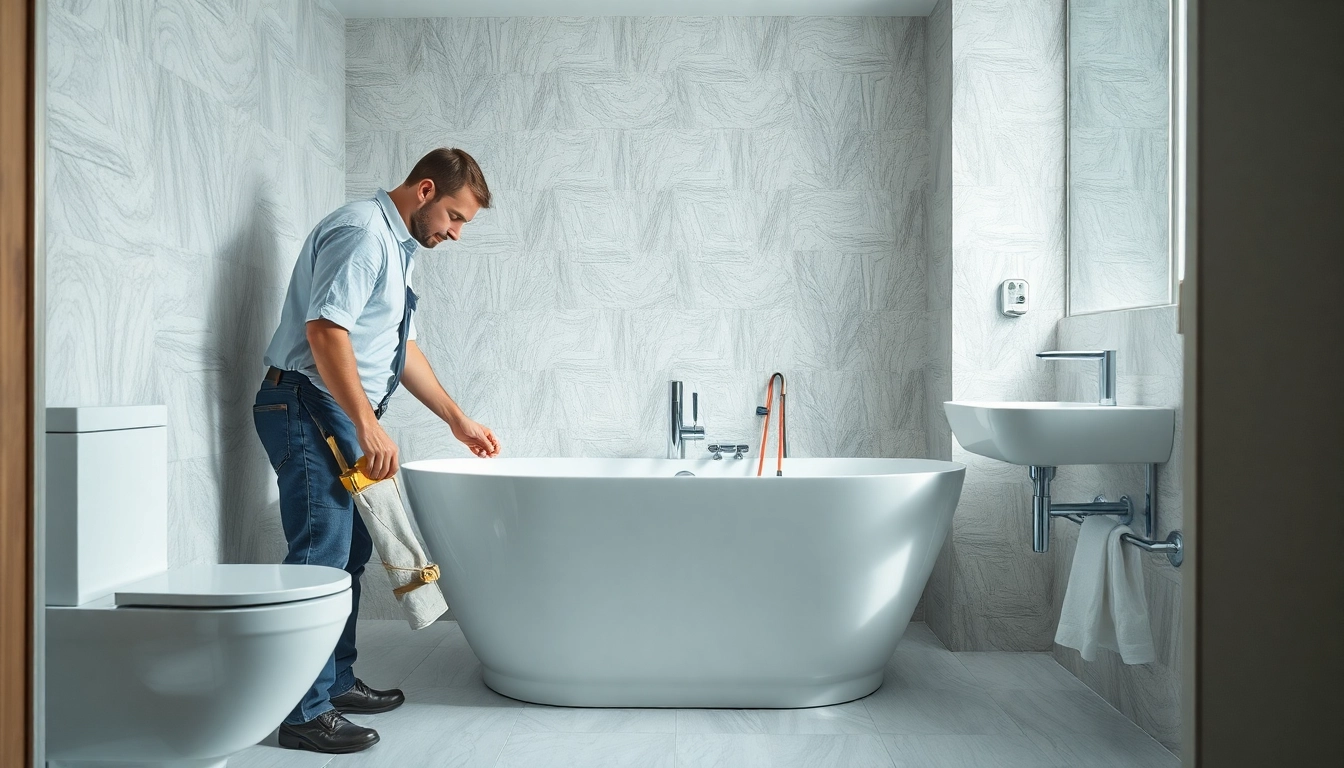Essential Guide to Bathroom Fitters: Transform Your Space in 2025

Understanding the Role of Bathroom Fitters
In the realm of home improvement, the expertise of bathroom fitters plays a critical role. These skilled professionals are tasked with transforming our personal sanctuaries into functional yet luxurious spaces. Whether you’re contemplating a minor update or a full-scale remodel, understanding what bathroom fitters do will help you appreciate their significance in the renovation process.
What Do Bathroom Fitters Do?
Bathroom fitters specialize in the installation and renovation of bathroom features, including sinks, showers, bathtubs, toilets, and storage solutions. Their responsibilities encompass the entire fitting process, which consists of:
- Design Consultation: Collaborating with clients to develop a design that meets their practical needs and aesthetic preferences.
- Demolition: Removing old fixtures, tiles, and plumbing as necessary to prepare for new installations.
- Plumbing and Electrical Work: Ensuring all plumbing and electrical components are safely and properly connected.
- Installation: Fitting new fixtures, cabinetry, and flooring according to the agreed design.
- Finishing Touches: Adding final touches, such as caulking, painting, and cleaning the new space.
Benefits of Hiring Professional Bathroom Fitters
Engaging seasoned bathroom fitters comes with numerous advantages:
- Expertise: Professional fitters bring extensive knowledge about installation techniques, product selection, and compliance with local building codes.
- Time Efficiency: Professionals can execute renovations more swiftly than most homeowners, leading to shorter project timelines.
- Quality Assurance: The work performed by professionals typically comes with warranties, ensuring peace of mind regarding the durability of the installation.
- Customization: Skilled fitters can provide tailored solutions that reflect your style and usage needs, enhancing both practicality and aesthetics.
Key Qualifications to Look For
When hiring a bathroom fitter, it’s essential to ensure they possess the necessary qualifications. Look for:
- Certifications: Ensure they have certifications in plumbing, electrical work, or general contracting.
- Experience: Ask about their years in the industry and request examples of previous work.
- References: Check for reviews or ask for references from previous clients to gauge their reputation and reliability.
- Insurance: Confirm that they carry liability insurance to protect you from potential damages or accidents during the project.
Choosing the Right Bathroom Fitter for Your Project
Finding the right bathroom fitter can make all the difference in the success of your renovation. To choose wisely, consider the following steps:
How to Evaluate Bathroom Fitters
Evaluation involves more than just comparing prices. Follow these steps to ensure proper assessment:
- Research: Begin by conducting online research to find local professionals and check their portfolios.
- Interviews: Speak directly to potential fitters to discuss your project and gauge their communication skills and enthusiasm.
- Quotes: Request detailed quotes that break down costs for labor, materials, and timelines.
- Contracts: Always read the contract carefully; it should include detailed descriptions of the work to be completed, the materials to be used, and payment terms.
Questions to Ask Before Hiring
During consultations, be sure to ask the following key questions:
- What is the anticipated timeline for my project?
- Can you provide references from past clients?
- Are you familiar with my specific bathroom style or any specific products I want?
- What is included in your quote, and what might incur additional costs?
Understanding Your Budget with Bathroom Fitters
Setting a realistic budget is pivotal. Here are a few strategies:
- Prioritize Needs vs. Wants: Identify essential renovations versus luxury add-ons to better allocate funds.
- Get Multiple Estimates: Collect several bids to understand market pricing and ensure competitive rates.
- Allocate a Contingency Fund: Expect to reserve an additional 10-20% of your budget for unforeseen expenses.
Common Challenges with Bathroom Fitting
While renovations can be exciting, they also come with their share of challenges. Some common issues include:
Dealing with Space Constraints
Bathrooms often have limited space, which can complicate renovations. Solutions for optimizing small spaces include:
- Utilizing wall-mounted fixtures to free up floor space.
- Incorporating built-in shelving for storage.
- Employing mirrors and light colors to create an illusion of space.
Managing Timelines and Expectations
Unexpected delays are common in renovations. Here’s how to stay on track:
- Set Realistic Deadlines: Understand that renovation may take longer than anticipated and factor this into your planning.
- Regular Communication: Maintain consistent communication with your bathroom fitter to receive updates on progress.
Handling Unexpected Issues During Installation
It’s important to prepare for the unexpected. Here’s how:
- Develop a Contingency Plan: Include provisions in your budget and timeline for potential setbacks.
- Stay Flexible: Be open to alternative solutions if issues arise, and consult your fitter for best practices.
Best Practices for a Successful Bathroom Renovation
Executing a successful bathroom renovation involves careful planning and consideration. Here are some best practices:
Planning the Perfect Layout with Bathroom Fitters
The layout of your bathroom can significantly impact its functionality. Optimize the space by:
- Creating a functional flow that ensures each element is easily accessible.
- Considering plumbing locations to minimize installation difficulty.
- Implementing zoning for wet and dry areas, particularly if space allows for separate bathing and dressing zones.
Selecting Fixtures and Features
Choosing the right fixtures is crucial for a cohesive bathroom design. Considerations include:
- Style Consistency: Opt for fixtures that complement the overall aesthetic of the home.
- Functionality: Select features with functionality in mind, such as anti-slip flooring or easy-access cabinets.
- Sustainability: Look for eco-friendly fixtures that conserve water and energy.
Maximizing Storage and Functionality
Functionality is key in a bathroom. Strategies for maximizing storage include:
- Incorporating multi-functional furniture such as vanities with drawers.
- Using vertical space for shelves or cabinets to store essentials.
- Leveraging under-sink space effectively with customized storage solutions.
Aftercare and Maintenance Post-Installation
Once your bathroom is complete, maintaining its new look and functionality is essential. Follow these tips for effective aftercare:
Essential Tips for Maintaining Your New Bathroom
To keep your bathroom in pristine condition, consider:
- Regularly cleaning surfaces to prevent mold and mildew.
- Addressing leaks promptly to avoid water damage.
- Using protective coatings on surfaces to maintain their appearance and durability.
Regular Checks and Updates to Ensure Longevity
It’s wise to schedule periodic maintenance to retain functionality and safety:
- Inspect plumbing connections and faucets for signs of wear or inefficiency.
- Check for grout cracks and reapply as necessary to prevent moisture penetration.
- Replace fixtures that have lost their efficiency or aesthetic appeal.
When to Call Your Bathroom Fitters for Help
While many issues can be handled on your own, knowing when to call your bathroom fitter can save you time and money. Seek professional assistance for:
- Major plumbing issues that require specialized knowledge and tools.
- Drastic renovations that involve structural changes.
- Advice on the latest trends and technologies in bathroom design and fixtures.






